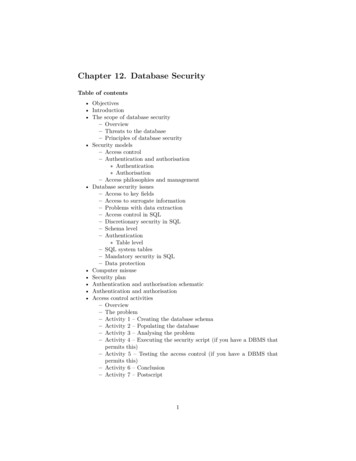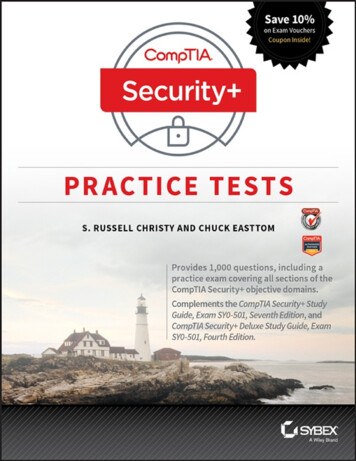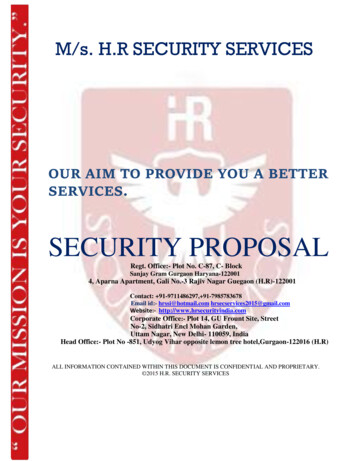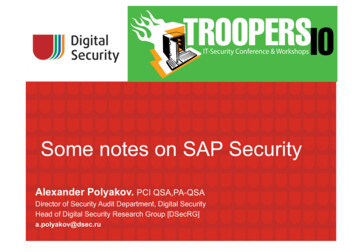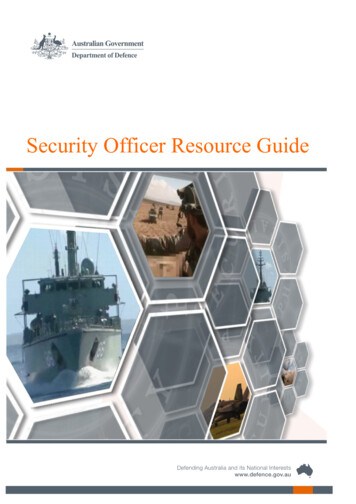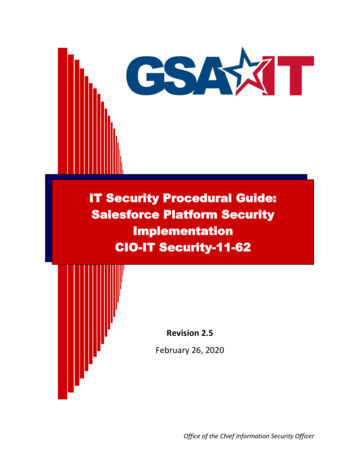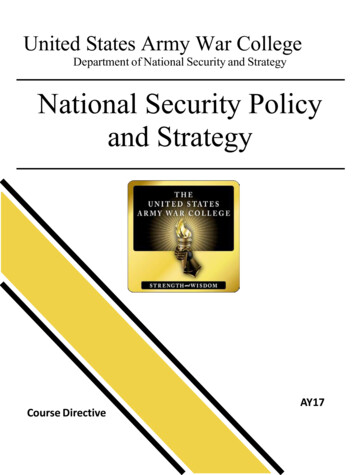
Transcription
United States Army War CollegeDepartment of National Security and StrategyNational Security Policyand StrategyCourse DirectiveAY17
This document contains educational material designed to promote discussion by studentsof the U.S. Army War College. It does not necessarily reflect the views of the Departmentof the Army.
INTENTIONALLY BLANKii
TABLE OF CONTENTSCOURSE OVERVIEW:PageGENERAL .PURPOSE.OUTCOMES .COURSE STRUCTURE AND KEY QUESTIONS.SCOPE.STUDENT READINGS.CURRICULAR RELATIONSHIPS.JOINT PROFESSIONAL MILITARY EDUCATION (JPME).COURSE REQUIREMENTS. .COURSE CALENDAR . .12224789910BLOCK I: THE NATIONAL SECURITY ENVIRONMENT AND DECISION-MAKINGMODELS111-S INTRODUCTION TO NATIONAL SECURITY POLICY AND STRATEGY.2-S INTERNATIONAL IMPACTS ON NATIONAL SECURITY DECISION-.MAKING: THE GLOBAL POLITICAL SYSTEM .3-S INTERNATIONAL IMPACTS ON NATIONAL SECURITY DECISION-.MAKING: THE GLOBAL ECONOMIC SYSTEM .4-S DOMESTIC IMPACTS ON NATIONAL SECURITY DECISION-MAKING:.U.S. HISTORY, VALUES, AND INTERESTS .5-S NATIONAL SECURITY DECISION-MAKING MODELS.6-S CASE STUDY I: CONTAINMENT AND NSC 68.13BLOCK II: NATIONAL SECURITY ACTORS AND INSTITUTIONS377-S THE AMERICAN POLITICAL SYSTEM I: THE PRESIDENCY AND THE NSC8-S THE AMERICAN POLITICAL SYSTEM II: CONGRESS AND .INTEREST GROUPS . . 9-L/S THE ROLE OF THE MILITARY IN NATIONAL SECURITY DECISIONMAKING .10-L/S CASE STUDY II: ESCALATION IN VIETNAM .39BLOCK III: INSTRUMENTS OF NATIONAL POWER5511-S INTRODUCTION TO THE INSTRUMENTS OF NATIONAL POWER .iii571721252933434751
12-L/S INSTRUMENTS OF NATIONAL POWER IN TIMES OF PEACE.13-S INSTRUMENTS OF NATIONAL POWER IN TIMES OF CONFLICT I .14-S INSTRUMENTS OF NATIONAL POWER IN TIMES OF CONFLICT II 616569BLOCK IV: CONTEMPORARY AMERICAN GRAND STRATEGY73x15-S NATIONAL STRATEGIC GUIDANCE & POSTURE 16-L/S THE 21ST CENTURY STRATEGIC ENVIRONMENT 17-S 21ST CENTURY AMERICAN GRAND STRATEGY . .757983APPENDICESAPPENDIX I: GUIDELINES FOR STRATEGY FORMULATION .APPENDIX II: COURSE WRITING REQUIREMENTS AND GUIDLELINES .APPENDIX III: NSPS STUDENT CRITIQUE 8793100APPENDIX IV: USAWC PROGRAM LEARNING OUTCOMES .APPENDIX V: JOINT LEARNING AREAS AND OBJECTIVES (JPME II).APPENDIX VI: AY17 THEMES .APPENDIX VII: BLOOM’S TAXONOMY .APPENDIX VIII OFFSITE ACCESS TO COURSE READINGS, LIBRARYDATABASES, AND BLACKBOARD .APPENDIX IX: PROGRAM LEARNING OUTCOMES (PLOS)—CURRICULUM .MAP 101103106108APPENDIX X: JOINT LEARNING AREAS AND OBJECTIVES—CURRICULUMMAP .MAP iv110112113
COURSE OVERVIEW The values of our founding inspire leaders in parliaments and newmovements in public squares around the globe. And when a typhoon hits thePhilippines, or schoolgirls are kidnapped in Nigeria, or masked men occupya building in Ukraine, it is America that the world looks to for help. So theUnited States is and remains the one indispensable nation. That has beentrue for the century passed and it will be true for the century to come.But the world is changing with accelerating speed. This presents opportunity,but also new dangers. We know all too well, after 9/11, just how technologyand globalization has put power once reserved for states in the hands ofindividuals, raising the capacity of terrorists to do harm.Russia’s aggression toward former Soviet states unnerves capitals inEurope, while China’s economic rise and military reach worries its neighbors.From Brazil to India, rising middle classes compete with us, andgovernments seek a greater say in global forums. It will be your generation’s task to respond to this new world. The questionwe face, the question each of you will face, is not whether America will lead,but how we will lead -- not just to secure our peace and prosperity, but alsoextend peace and prosperity around the globe.―President Barack H. ObamaRemarks by the President at the United States Military AcademyCommencement Ceremony - May 20141. General.a. The National Security Policy and Strategy (NSPS) course focuses on nationalsecurity policies and the strategies that put them into operation. It examines the elementsthat underpin national security policy and strategy, including the international and domesticenvironments, the American political system, national security policy and strategyformulation, the instruments of national power, and the processes employed by the United1
States Government for integrating and synchronizing those instruments to formulatenational security policies and strategies in the pursuit of national security objectives. Thecourse also examines the role of the current national strategic documents to include theNational Security Strategy (NSS), the Defense Strategy Review (formerly known as theQuadrennial Defense Review (QDR)), and the National Military Strategy (NMS), amongothers.b. During NSPS, the Department of National Security and Strategy (DNSS) faculty’sgoal is to provide a positive adult learning environment through seminar discussions,readings, case studies, guest lectures, and question and answer periods. Throughout thecourse, the faculty will challenge students to evaluate complex national security issuesthat are often characterized by ambiguity and uncertainty using critical, creative, ethical,and systemic thought processes, as well as historical/contextual reflection and analysis.c. The synthesis, analysis, evaluation and application of national security policy, andthe military's role within the interagency decision-making process, conform to noprescribed doctrine. Strategic thinking requires creativity as well as discipline in grapplingwith the complex and dynamic matters of policy, strategy, and the use of national powerto promote and protect national interests. National security strategists in the 21st Centurymust effectively operate in a complex, ambiguous and rapidly-changing environment.Strategists must be able to integrate the multiple dimensions of the global environment,as well as factors such as culture, international and domestic politics, economics, publicpolicy, and technology. Upon completion of the NSPS course, students will be better ableto analyze complex and ambiguous national security issues, providing a solid foundationfor their prospective service at the strategic level.2. Purpose. The purpose of the NSPS course is to develop senior military and civilianleaders who understand the art and practice of policy and strategy formulation in achievingnational security objectives in the current and emerging global environment.3. Outcomes. The NSPS course outcomes are:a. Analyze the process of national security policy and strategy formulation and themajor factors that influence this process.b. Analyze and understand contemporary and emerging international securitychallenges and their impact on the national security agenda.c. Synthesize key concepts, tools, and processes in the development of appropriatepolicy and strategy responses to national security challenges facing the United States inthe 21st Century international security environment.4. Course Structure and Key Questions. The course is divided into four blocks, each ofwhich revolves around one or more key questions in the national security decisionmaking process.2
Block I: The National Security Environment and Decision-Making Models. The firstblock provides a conceptual foundation for understanding national security decisionmaking. Lessons in this block examine the key concepts underpinning national securitypolicy and strategy, discuss the environments – both international and domestic – inwhich policy and strategy formulation take place, and examine a set of decision-makingmodels that attempt to explain why governmental decision-making often deviates from apurely rational process that produces value-maximizing decisions. Block I of the courseends with a case study that examines the development of NSC-68, the document thatarticulated and defended the strategy of containment of the Soviet Union in the ColdWar. Questions examined in Block I include:a. How should national security be defined and what national interests flow from thisdefinition of national security?b. How are policy and strategy defined and what is the relationship between them?c. What are the key factors in the contemporary international environmentthat shape U.S. national security policy and strategy?d. How do historical experience and the characteristics of the U.S. political systeminfluence U.S. national security policy and strategy?e. What influence do bureaucratic politics, group dynamics, and the characteristics ofindividual decision-makers have on national security policy and strategy?Block II: National Security Actors and Institutions. The second block of the courseexamines the key actors and institutions in the national-security decision-making process.Among the actors and institutions examined are the President, the National SecurityAdvisor and the National Security Council, the Congress, interest groups, and theWashington, D.C.-based military establishment of the Joint Staff and the Office of theSecretary of Defense. This block examines how these actors and institutions interact toformulate and implement national security policy and strategy. A key insight of this blockis that interaction among these actors and institutions is dynamic - sometimes cooperativeand sometimes competitive – with shifting coalitions of actors shaping policy and strategy,and personalities often playing a significant role. Block II ends with a case study on theU.S. decision to escalate the war in Vietnam, in which students play the roles of keyactors in that process. Questions examined in Block II include:a. Who are the key actors—whether individuals or institutions—in the nationalsecurity community and what factors shape interaction among them?b. How do civilian and military roles in the national security decision-making processdiffer, and what is the proper role of the military in this process?c. What are the characteristics of the interagency process (as it has developed overthe past 60 plus years) in the formulation and implementation of national security policy3
and strategy?Block III: Instruments of National Power. The third block of the course examines theinstruments of national power and how the United States uses them to achieve itsnational security objectives. Lessons in this block provide an overview of theinstruments of diplomacy, information, military and economic power, and then examinehow the U.S. uses these instruments during times of peace and times of conflict. A keyinsight of Block III is that the nation uses the instruments of power in an integratedmanner – while one instrument may dominate in a given situation, the other instrumentsare also engaged in support of U.S. objectives in that situation. Questions examined inBlock III include:a. What are the instruments of U.S. national power and what are their relationshipswith one another?b. What are the key characteristics of each instrument of power and whatconsiderations guide its use?c. How might the United States most effectively wield its national power to meet thechallenges and opportunities of the 21st Century?Block IV: Contemporary American Grand Strategy. The fourth and final block of thecourse examines national security policy and strategy in the 21st Century. The lessonsof this block examine key U.S. national security documents, survey the contemporaryglobal security environment and the issues that dominate it, and examine competingvisions for 21st Century U.S. grand strategy. Questions examined in Block IV include:a. In light of current circumstances, and projected forces and trends for the future,what national security priorities do you think should be reflected in national-level strategydocuments (e.g., the National Security Strategy, Defense Strategy Review, and NationalMilitary Strategy)?b. What types of national security policies and strategies will most effectively advanceU.S. national interests over the next 10-20 years?c. What lessons on the formulation and implementation of national security policy andstrategy can be drawn from the study of major national security decisions in U.S. history?5. Scope. The national security professional must be as flexible, adaptable, and capableas the challenges our nation faces. During the National Security Policy and Strategycourse, students should expect to do something that may appear paradoxical: to thinkclearly about ambiguous problems arising from complex circumstances. We willanalyze and evaluate these problems from the perspective of those occupying thehighest national security positions in our government—both civilian and military. Despitethe uncertainty of issues and circumstances, students will be expected to offeroptions/solutions even when no obvious correct answer seems to emerge. This is nosmall task; however, it can be rewarding when approached with a creative, critical, and4
informed outlook. What follows is a discussion of a key aspect of the course: theUSAWC Strategy Formulation Framework.a. Strategy Formulation Framework.Figure 1.(1) The “Strategy Formulation Framework” (Figure 1) offers one way toconceptualize the overall objectives of this course. This framework is examined in detailin Appendix I of this document. The central part of the framework depicts a logical5
approach to organizing our thoughts regarding strategy formulation. Policy flows from thepath of U.S. historical development and the continuing political process. It is derived fromour nation’s enduring beliefs, ethics, values, and previous choices. Policy may be definedas broad guidance that articulates national interests in the context of the strategicenvironment. National policy provides the focus for strategy formulation. Strategy at thehighest level of decision-making is often referred to as Grand Strategy, which may bedefined as the use of all instruments of national power in peace and war to support astrategic vision of America’s role in the world that will best achieve national objectives.However, it is important to remember that all strategy is a calculation of ways and meansdirected towards the accomplishment of ends, balanced against a continuous assessmentof risk.(2) Evolving from U.S. history and practice, strategy formulation begins with anunderstanding of the nation's values, purpose, and strategic culture. National values,based on the nation’s enduring beliefs and ethics, significantly influence the identificationof national interests. The strategist can then conduct an appraisal of the challenges andopportunities that affect these interests—as well as the nation’s ability to promote andprotect them. The core national interests of the United States generally revolve aroundthe security of the United States, its citizens, and its allies; economic well-being; a stableinternational order; and the promotion of national values. However, the strategist mustunderstand that these core interests, though enduring, may be influenced by the history ofthe U.S., the current context of the times, the domestic mood, and the internationalsecurity climate.(3) A strategist will base an effective strategic appraisal on a realisticunderstanding of the international and domestic environments and an analysis of themany trends and forces operating in those environments (depicted in the boxes on the leftand right sides of the framework diagram). Based on this appraisal, political leadersarticulate a grand strategic vision of the nation’s role in the world. Policymakers andstrategists then translate this grand strategic vision into grand strategic objectives(ENDS). This vision also guides the choice of grand strategic concepts (WAYS; i.e.,engagement, containment, or preeminence) based on a broad conception of nationalpower (MEANS), resulting in broad national policy decisions. Key departmental andagency leaders continue the strategy formulation process at the national security level,focusing on a more detailed examination of national interests, considered by categoriesand intensities. As part of this process, the President determines overall national securitypolicy objectives and approves a national security strategy for employing the instrumentsof national power – diplomatic, informational, military, and economic (DIME) – to achievenational interests. Strategists then work to provide the President and other keypolicymakers with strategy options to serve the policy objectives.(4) A key analysis for policymakers and strategists is a risk assessment todetermine feasibility (Do we have the means to execute the strategy?), acceptability(Does the strategy accord with the preferences of key audiences? Is it legal? Ethical? Arecosts likely to be borne?), and suitability (Will the strategy achieve or contribute usefully tothe national policy objectives?). Additionally, this analysis helps identify and assess thepossible second and third order effects involved in implementing the strategy (e.g., the6
impact of the strategy on another country, region, the economy; or the potential impact ofresource constraints on strategy implementation). Ideally, such a process leads to thedevelopment of the National Security Strategy and derivative strategies such as theQuadrennial Defense Review/Defense Strategy Review and the National Military Strategyamong others. At all levels, the strategy formulation process has the same four elements:ways and means in the service of ends accompanied by a thorough risk assessment. Thisprocess is designed to develop appropriate strategies to achieve specific policy goals insupport of U.S. national interests.(5) The Strategy Formulation Framework may imply that a rational, sequential ordeliberative approach to policy and strategy formulation exists at the core of policymaking.However, the formulation of national security strategy is not always a smooth process:"means" and "ends" often may not match; various "ways" can interfere with, rather thancomplement, one another; and specific actions and outcomes may not conform exactly toinitial intentions. An even more fundamental critique of this framework is to recognize thatstrategy formulation is not a linear process. Comprehending the dynamic interaction ofall of these steps is why the strategy-making environment often mirrors the 21st Centuryinternational security environment—it is complex and ambiguous.(6) The dynamic and interactive nature of the national security strategy formulationprocess is difficult to depict graphically. The flanking boxes of Figure 1 represent theinternational and domestic environments within which the process occurs. These boxessuggest how a host of real world forces, external to the process, can influence it. The twoway arrows in the strategy formulation block show that while the framework appearssequential, every part really depends on every other part, and that strategy requires anon-going assessment of the relationships between ends, ways, and means. Finally,strategy development is not a solitary pursuit; multiple actors from both the internationaland domestic domains (Congress, the federal bureaucracy, interest groups, other nations,regional and international organizations, and non-state actors) influence the process. U.S.policy and strategy pronouncements and changes will cause strategy responses andadjustments by these actors that, in turn, influence subsequent U.S. actions. Thus, thisprocess is always dynamic with a continual need to assess and reassess the execution ofa strategy. A key task in this course will be to understand and appreciate one of the mostcomplex national security processes of the U.S. government.6. Student Readings. Student readings will be annotated as follows:a. "Student Issue”--Items received prior to the start of the academic year ordistributed by the faculty during the year.b. "Blackboard"--Copyright items provided digitally via Blackboard.c. "Library Reserve”--Items placed on NSPS reserve in the library. (Please ask thelibrarians for assistance if you have any difficulty in locating a suggested reading).d. “Database”--Library provided databases: “ProQuest”, “JSTOR”, “Taylor andFrancis”, “EBSCOHOST”, or others -- Resources available through accessing USAWC7
Library remote access. For link to the reading, see Appendix VIII and USAWC LibraryStaff for username and password.e. "Online"--Open source online resources available on the Internet. All internetaccessible required reading resources will have a hyperlinked web address to indicatethat the material is an open source, online document.7. Curricular Relationships. NSPS will complement lessons contained in the USAWCIntroduction to Strategic Studies (ISS), Theory of War and Strategy (TWS) and StrategicLeadership (SL) courses. In TWS we examined the theory of strategy and its historicalapplication and evolution, which should enable the student to more profoundlycontemplate the theoretical underpinnings of contemporary U.S. strategies andchallenges. The Strategic Leadership course laid the foundation for the NSPS course byproviding the concepts and skills required of leaders within the strategic environmentthrough an examination of responsible command, leadership, management practices,and group decision-making dynamics.a. NSPS builds upon the lessons contained in SL by focusing on case studies ofstrategic decision-making and crisis management. This foundation should enablestudents to more insightfully examine the contemporary (and some future) strategicchallenges in the global environment, followed by an examination and evaluation of thestrategy formulation process, the elements of national power and statecraft wielded by theUnited States, and the processes for synchronizing and integrating those instruments.NSPS will facilitate the continued study and application of key strategic concepts andtheories regarding the use of force covered in Theory of War and Strategy, as well as theintegration of the military instrument of national power with the other instruments toinclude diplomatic, informational, and economic ones.b. Additionally, the course will continue to build upon the roles and competencies ofstrategic leaders introduced in the Strategic Leadership course – especially critical,creative and systems thinking, ethical reasoning, and decision-making. Moreover, NSPSwill provide the conceptual tools for work in the remaining three core courses, TheaterStrategy and Campaigning (TSC), Defense Management (DM), and the RegionalStudies Program (RSP) in which students study the various systems for strategicplanning, providing the military capabilities in support of the national military strategy,and planning for global and theater military operations. NSPS will also provide a venuefor discussion on the subject of the “means” behind U.S. policy and strategy byexamining how America resources its wars, and the relationship of U.S. economic powerto military power that provides a foundation for further examination of these issues inDM.8. Joint Professional Military Education (JPME II). Joint Learning Areas are integratedinto the resident core curriculum. NSPS provides the student with the foundation forunderstanding national security policy formulation, national and military strategy, andthe national and international security environments. Specific Joint Learning Areas arelisted in Appendices V and X of this directive. JPME Phase II Joint Learning Areas aretaken from Appendix E to Enclosure E to Officer Professional Military Education Policy,8
CJSCI 1800.01E, current as of 29 May 2015.COURSE REQUIREMENTSIn order to complete NSPS successfully, students will meet established standards ineach of the two basic requirements listed below. Each requirement will be evaluated bythe Faculty Instructor (FI) throughout the course.1. Contribution: The essential requirement to achieve the overall objectives of NSPS isactive participation in the seminar-learning environment. Through active participation,students contribute to the learning of others. Contribution includes interaction with guestspeakers. Students are expected to contribute by accomplishing the required readings,research, and tasks listed in paragraph 3, Student Requirements, for each lesson or asassigned or modified by the Faculty Instructor. Active learning begins with thorough andthoughtful preparation. Contribution will comprise 30 percent of the overall NSPS grade.2. Written Requirements:a. Requirements. Each student will complete a single writing requirement in twoparts. Refer to Appendix II for a detailed description of these requirements. The first partof the writing requirement will be a single page, single-spaced bulletized paper articulatingand testing a strategy to implement a policy option selected from a list provided by theFaculty Instructor. The second paper will be a 6-8 page, double-spaced backgroundpaper on the same topic. The audience for both papers is a senior Department ofDefense decision-maker. The goal of the first paper is to concisely encapsulate arecommended strategy for his/her decision; the goal of the second paper is to providehim/her more background information on the topic. These papers are intended to besubmitted and graded together, and are meant to simulate the type of writingrequirements often found within the national security policy and strategy enterprise.b. Evaluation Standard. Written assignments will be evaluated based on content,organization, and style. The criteria for evaluating papers will be the student’sdemonstrated understanding of and ability to apply course concepts, to organize materiallogically, and to compose and express thoughts clearly and coherently through effectivewriting. Descriptions of the criteria for “Outstanding,” “Exceeds Standards,” “MeetsStandards,” “Needs Improvement,” and “Fails to Meet Standards” are found in theCommunicative Arts Directive. A paper evaluated as “Needs Improvement” or "Fails toMeet Standards" will be returned to the student for rework and resubmission. The paperswill be graded as a single assignment and together will comprise 70 percent of the overallNSPS grade.9
October-NovemberMonTueWedThuFri1718192021NSPS-1: Introduction24NSPS-2: GlobalPolitical Order25NSPS-3: GlobalEconomic Order26RWR27NSPS-4: History,Values and Interests28NSPS-5: DecisionMaking ModelsNTL: Duckenfield –Global EconomicOrderNTL: Troxell –Financial Power31NSPS-6: NSC-68Case Study1NSPS-7: Presidencyand NSC2RWR3NSPS-8: Congressand Interest Groups4NSPS-9: Military in thePolicy ProcessNTL: Ulrich – CivilMilitary RelationsBH Lecture (0830):Barno & Bensahel Military in the PolicyProcess10NSPS-13: Instrumentsof Power in Conflict I11Holiday –Veterans’ DayNTL: Troxell –China’s EconomicRise7NSPS-10: VietnamEscalation CaseStudy(0830-1230)8NSPS-11: Instrumentsof Power OverviewBH Lecture (1130):Grossman –Diplomacy as anInstrument ofStatecraftBH Lecture (0830):Jones – The 1965Vietnam Escalation14NSPS-14:Instruments ofPower in Conflict IINTL: Rapp – TheIraq Surge9NSPS-12: Instrumentsof Power in Peacetime(1300-1600)15NSPS-15: StrategicGuidance16SRP-5NTL: Hamilton – TheU.S. and Russia inSyriaNTL: Berry – TheArctic17NSPS-16:21st CenturyStrategicEnvironment18NSPS-17: 21st CenturyGrand StrategyPapers dueBH Lecture (0830):Manuel – 21st CenturyGrand StrategyNTL: Hillison & Gellert– U.S. Trade Policy10
BLOCK ITHE NATIONAL SECURITY DECISION-MAKING ENVIRONMENT AND MODELSNo other society has asserted that the principles of ethical conduct apply tointernational conduct in the same way that they do to the individual—anotion that is the exact opposite of Richelieu’s raison d’état. America hasmaintained that the prevention of war is as much a legal as a diplomaticchallenge, and that what it resists is not change as such but the method ofchange, especially the use of force.A Bismarck or a Disraeli would have ridiculed the proposition that foreignpolicy is about method rather than substance; if indeed he had understood it.No nation has ever imposed the moral demands on itself that America has.And no country has so tormented itself over the gap between its moralvalues, which are by definition absolute, and the imperfection inherent in theconcrete situations to which they must be applied.―Henry KissingerDiplomacyNSPS is designed to broaden our strategic level conception and understanding of the U.S.position in the current global order through a survey of international and U.S. domesticnational security and policy systems. Block I begins with an examination of the strategyformulation process and introduces the USAWC Strategy Formulati
strategy can be drawn from the study of major national security decisions in U.S. history? 5. Scope. The national security professional must be as flexible, adaptable, and capable as the challenges our nation faces. During the National Security Policy and Strategy course, students should exp

